
Harrisburg is the capital city of the U.S. commonwealth of Pennsylvania and the seat of Dauphin County. With a population of 50,099 as of 2020, Harrisburg is the ninth-most populous city in Pennsylvania. It is the larger principal city of the Harrisburg–Carlisle metropolitan statistical area, also known as the Susquehanna Valley, which had a population of 591,712 in 2020 and is the fourth-most populous metro area in Pennsylvania. Harrisburg is situated on the east bank of the Susquehanna River and is located 83 miles (134 km) southwest of Allentown and 107 miles (172 km) northwest of Philadelphia.

Columbia, formerly Wright's Ferry, is a borough (town) in Lancaster County, Pennsylvania, United States. As of the 2020 census, it had a population of 10,222. It is 28 miles (45 km) southeast of Harrisburg, on the east (left) bank of the Susquehanna River, across from Wrightsville and York County and just south of U.S. Route 30.

Williamsport is a city in and the county seat of Lycoming County, Pennsylvania, United States. As of the 2020 census, it had a population of 27,754. It is the principal city of the Williamsport Metropolitan Statistical Area, which has a population of about 114,000. Williamsport is the larger principal city of the Williamsport-Lock Haven Combined Statistical Area, which includes Lycoming and Clinton counties.

The Susquehanna River is a major river located in the Mid-Atlantic region of the United States, crossing three lower Northeast states. At 444 miles (715 km) long, it is the longest river on the East Coast of the United States. By watershed area, it is the 16th-largest river in the United States, and also the longest river in the early 21st-century continental United States without commercial boat traffic.

The Rockville Bridge is the longest stone masonry arch railroad viaduct ever built, at 3,820 feet (1,160 m). It has 48 70-foot spans.

The Cumberland Valley is a northern constituent valley of the Great Appalachian Valley, within the Atlantic Seaboard watershed in Pennsylvania and Maryland. The Appalachian Trail crosses through the valley.
The Lehigh and New England Railroad was a Class I railroad located in Northeastern United States that acted as a bridge line. It was the second notable U.S. railroad to file for abandonment in its entirety after the New York, Ontario and Western Railway. It was headquartered in Philadelphia.

The Northern Central Railway (NCRY) was a Class I Railroad in the United States connecting Baltimore, Maryland, with Sunbury, Pennsylvania, along the Susquehanna River. Completed in 1858, the line came under the control of the Pennsylvania Railroad (PRR) in 1861, when the PRR acquired a controlling interest in the Northern Central's stock to compete with the rival Baltimore and Ohio Railroad (B&O).

The Susquehanna River Bridge carries Interstate 76 across the Susquehanna River between Dauphin and York County near Harrisburg, Pennsylvania.
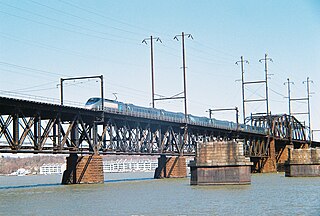
The Amtrak Susquehanna River Bridge is a Howe deck truss structure, opened in 1906, that carries two tracks of Amtrak's Northeast Corridor line across the Susquehanna River between Havre de Grace and Perryville, Maryland.

The CSX Susquehanna River Bridge is a railroad bridge that carries CSX's Philadelphia Subdivision across the Susquehanna River between Havre de Grace and Perryville, Maryland, via Garrett Island. It was built in 1907–1910 by the Baltimore and Ohio Railroad (B&O) on the same alignment as an 1886 B&O bridge. Like its predecessor, it was the longest continuous bridge on the B&O system.

The Philadelphia & Reading Railroad Bridge carries Norfolk Southern rail lines across the Susquehanna River between Lemoyne, Pennsylvania and Harrisburg, Pennsylvania. Some of its concrete piers encase stone masonry piers from an earlier truss bridge on this site, completed in 1891 by the Philadelphia, Harrisburg and Pittsburgh Railroad, which was then acquired by the Philadelphia and Reading Railroad to connect its Harrisburg and Lurgan lines. The current structure was constructed from 1920 to 1924 by replacing the trusses with concrete arches one track at a time. The bridge has fifty-one concrete arches, three more than the nearby Rockville Bridge.
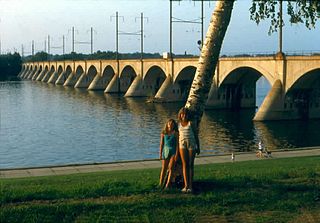
The Cumberland Valley Railroad Bridge is a currently unused railroad bridge.
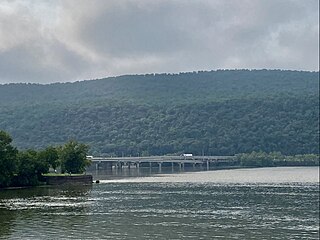
The Clarks Ferry Bridge is a plate girder bridge that carries U.S. Routes 22 and 322 across the Susquehanna River near Duncannon, Pennsylvania, about 20 miles north of Harrisburg, Pennsylvania. It is a 4 lane expressway standard bridge. The bridge also provides safe passage for hikers, bikers, and pedestrians using the Appalachian Trail and BicyclePA Route J. It was completed in November 1986 replacing a 1925 concrete arch toll bridge. At this location, 7 different bridges have crossed the river.
Theodore Burr was an inventor from Torrington, Connecticut, who was credited with the Burr Arch Truss bridge design. He designed and built one of the first bridges across the Hudson River and several bridges that crossed the Susquehanna River.
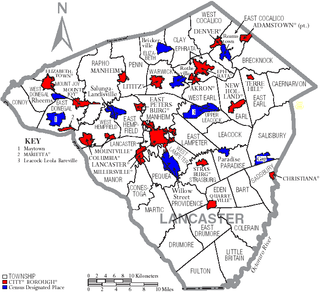
Transportation in Lancaster County, Pennsylvania has a long and variegated history. An early-settled part of the United States, and lying on the route between Philadelphia and Harrisburg, it has been the site of early experiments in canals, railroads, and highways. Before all these, at least ten Native American paths crossed parts of the county, many connecting with the Susquehannock village of Conestoga.
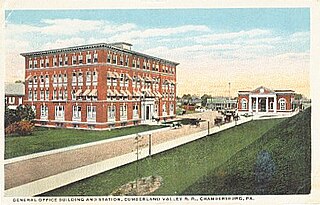
The Cumberland Valley Railroad was an early railroad in Pennsylvania, United States, originally chartered in 1831 to connect with Pennsylvania's Main Line of Public Works. Freight and passenger service in the Cumberland Valley in south central Pennsylvania from near Harrisburg to Chambersburg began in 1837, with service later extended to Hagerstown, Maryland, and then extending into the Shenandoah Valley to Winchester, Virginia. It employed up to 1,800 workers.

U.S. Route 11 (US 11) roughly parallels Interstate 81 (I-81) in the U.S. state of Pennsylvania. The route runs from the Maryland state line in Antrim Township, Franklin County, northeast to the New York state line in Great Bend Township, Susquehanna County. US 11 serves Harrisburg, Wilkes-Barre, and Scranton. Between Harrisburg and Scranton, US 11 follows the Susquehanna River, while I-81 follows a shorter route over the mountains further to the east.

The P.W. & B. Railroad Bridge was the first bridge over the Susquehanna River, built by the Philadelphia, Wilmington and Baltimore Railroad in 1866, as part of the first mainline railroad between Philadelphia and Baltimore. The bridge was replaced by the Susquehanna River Movable Bridge in 1906.

The Atglen and Susquehanna Branch is an abandoned branch line of the Pennsylvania Railroad that ran between Lemoyne and Atglen, Pennsylvania. A portion of the line is now the Enola Low Grade Trail.


















